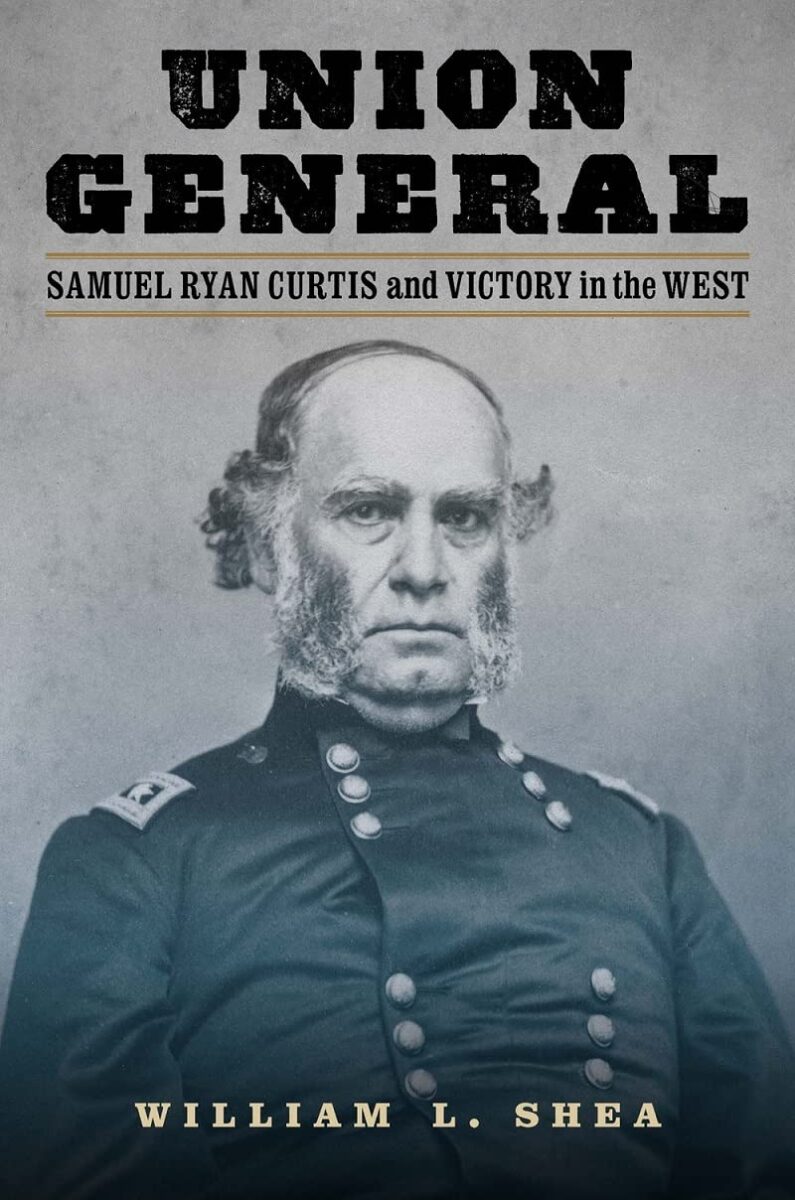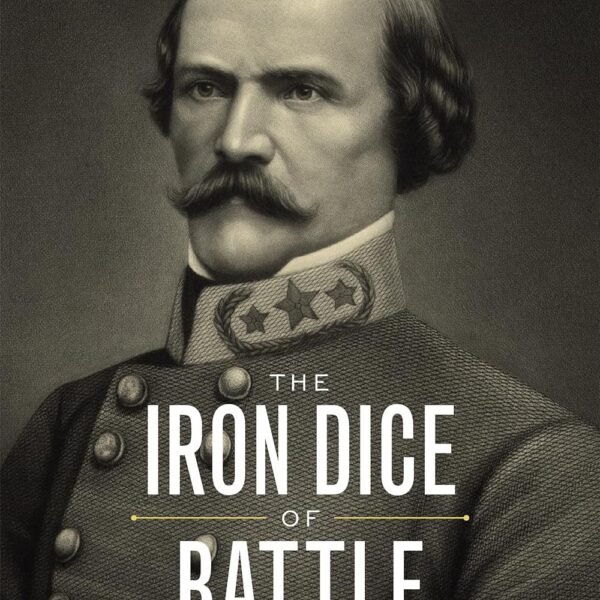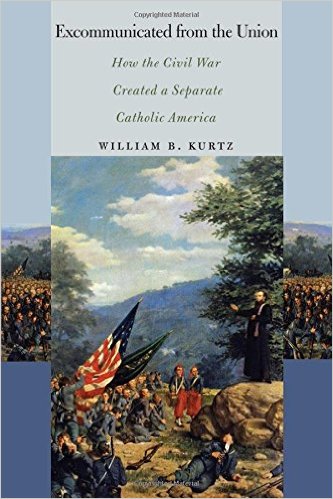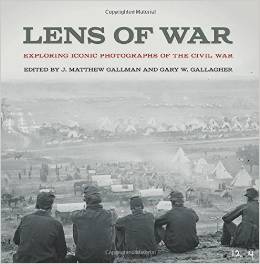William L. Shea is a prolific scholar of the U.S. Civil War in the Western and Trans-Mississippi Theaters. He has co-authored, with Earl J. Hess, Pea Ridge: Civil War Campaign in the West and, with Terrence J. Winschel, Vicksburg in the Key: The Struggle for the Mississippi River. Shea has also written an important study of the Prairie Grove Campaign. In Union General, he turns his attention to Samuel Ryan Curtis, the victor of Pea Ridge, who was, Shea argues, “the most important figure in the Civil War west of the Mississippi River” (ix).
Curtis, Shea continues, “influenced the course of events in a half-dozen states and territories and personally led U.S. forces to victory in two remarkable campaigns” (ix). In addition to compiling this impressive record, Curtis also “dealt a heavy blow to slavery in the trans-Mississippi months before emancipation became the law of the land” (ix).
In the century and a half since his death, Curtis has not received much attention from Civil War historians. This cradle-to-grave biography illuminates the fascinating life of an important, if often overlooked, general during the U.S. Civil War.
Born on February 3, 1805, Curtis grew up in central Ohio. His older brothers Hosmer and Henry consistently helped Curtis advance in the world. In 1823, they convinced Amos Caffee, the Licking County clerk of court, to hire Curtis as a clerical assistant. In 1825, they arranged employment for him in Robert McComb’s dry goods store in Mansfield. Eighteen months later, they helped him secure an appointment to the United States Military Academy. Shea speculates that Curtis’s fascination with internal improvements likely led him to choose West Point, since he “had no discernible interest in a military career except as a means to an end.” West Point, of course, “provided an opportunity to acquire a ‘scientific education’” (6).
Curtis graduated twenty-seventh in a class of thirty-three in 1831, and he was made a brevet second lieutenant in the Seventh Infantry, stationed at Fort Gibson. Curtis married Belinda Buckingham on November 3, 1831. In June 1832, he resigned his commission, returned to civilian life, and became involved in internal improvement projects. In 1837, the Ohio Board of Public Works made him resident engineer of the Muskingum River Improvement. Curtis did not see the project through to completion because he was a Whig and a new majority Democrat board fired him in 1839.
With the outbreak of the U.S. War with Mexico in 1846, Curtis became adjutant general of Ohio, an office he resigned to command the Third Ohio Volunteer Regiment. If he learned anything from this war, “it was that raising and drilling troops and leading them into battle were only part of a successful military operation” (27). Curtis spent most of the war on occupation duty and, at one point or another, “governed, administered, and defended Matamoros, Camargo, Monterrey, and Saltillo” (41). After the war ended, Curtis returned to civilian life and continued his engineering career, including stints as the head of the Des Moines River Improvement Project, city engineer for St. Louis, and the chief engineer of the Philadelphia, Fort Wayne, and Platte River Airline Railroad. In 1854, Curtis returned to Iowa and embarked on a political career. He was elected mayor of Keokuk in April 1856. Iowa Republican encouraged him to run for the House of Representatives in 1856, which he did and won. Curtis won reelection in 1858 and 1860.
When Abraham Lincoln won the presidency in 1860, seven southern states seceded before his inauguration. Four more followed after the firing on Fort Sumter. At the hour of the Union’s greatest peril, Curtis joined the army again. Winfield Scott encouraged him to obtain an officer’s commission from Iowa and use his position “on the House military affairs committee to support several pending army reform bills” (90). Curtis initially declined command of the First Iowa Volunteer Infantry to focus on his duties in Congress. However, the War Department appointed him mustering officer for Iowa, and Governor Samuel J. Kirkwood put Curtis in charge of the assembly point for Iowa volunteers at Keokuk. Curtis began organizing men into soldiers. On June 2, 1861, the officers of the Second Iowa Volunteer Infantry elected Curtis their commanding officer. Curtis cooperated with General Nathaniel Lyon and, upon Lyon’s request, took his soldiers to St. Joseph, Missouri, via Hannibal, to put down traitors. This, Shea notes, was “an unusually bold undertaking at this early stage of the Civil War” (93).
After the debacle at Bull Run, Lincoln appointed Curtis Brigadier General of Volunteers. Henry W. Halleck placed Curtis in command of the District of Southwest Missouri on Christmas Day 1861. Although Halleck never explained his reasoning why, Curtis’s “West Point education, Mexican War experience, engineering background, political connections, and demonstrated ability to bring order out of chaos all counted in his favor” (105). Curtis had the dubious honor of commanding what Shea judges “the most difficult place in the trans-Mississippi to fight a war” (108).
A new rebel commander in the trans-Mississippi, Earl Van Dorn, looked to defeat Curtis and the Army of the Southwest in early March 1862. Van Dorn had several advantages—namely, three-to-two in manpower and four-to-three in artillery. No other rebel army, Shea observes, “ever marched off to battle with greater numerical superiority” (120). Van Dorn and Curtis confronted each other at Pea Ridge. During the battle, Curtis’s army executed a 180-degree change of front that was “a unique event in the history of the Civil War” (128). Curtis’s artillery barrage on March 8 was “the largest, most intense artillery barrage ever to take place on the North American continent up to that time” (129-130). The U.S. assault on March 8 “was one of the most picture-perfect assaults of the Civil War” (130-131). Curtis, Shea argues, fully deserves the credit for the victory. In fact, he was promoted to Major General of U.S. Volunteers on March 21 in recognition of this important achievement.
After the battle, Curtis kept his army between the rebels and Missouri until Van Dorn crossed the Mississippi, united with rebels at Corinth, and abandoned Arkansas, Missouri, and Indian Territory. The Army of the Southwest came within a whisker of taking Little Rock but did not because they were becoming worn down after such a long campaign. Interestingly, for several weeks, Curtis “operated independently of a base of supplies in hostile territory, the first time in the Civil War any army commander attempted such a daring maneuver” (148). Furthermore, in summer 1862, Curtis proposed to push down the Mississippi and take Vicksburg, when the city was lightly defended. “Under those circumstances,” Shea observes, “a sudden descent on the ‘Gibraltar of the Mississippi’ might have met with success. We will never know” (155).
After Halleck rebuffed his plan to take Vicksburg, Curtis turned his attention to the administration of Helena, where he began to emancipate enslaved persons and “probably freed more human beings from bondage than any other political, military, or religious leader in the first eighteen months of the Civil War” (149). His embrace of emancipation earned him enemies, including Frederick Steele. In September 1862, Curtis, the oldest Union general commanding in the field, received command of the Department of Missouri. Here, he supervised the Prairie Grove campaign, which featured the “first army-sized raid of the Civil War” on Van Buren, Arkansas (174). Curtis encountered trouble in Missouri, due to the state’s vicious factional politics. Furthermore, he was “plagued by a War Department investigation ostensibly aimed at the buying and selling of cotton in Helena” (188). This ordeal dragged on far longer than it should have, thanks to malicious machinations of men like Steele. In the end, “having never been formally charged, Curtis was never formally exonerated” (198).
Lincoln returned Curtis to active duty at the end of 1863 as commander of the Department of Kansas. For part of 1864, it seemed that Curtis would “end his military career chasing guerrillas and Indians through the brush, but fate had something else in store for him” (221).
This “something else” was Price’s 1864 campaign into Missouri. Steele in Arkansas and Rosecrans in Missouri did their best to stay out of Price’s way, “but that changed when the Army of Missouri collided with the Army of the Border. Unlike Steele and Rosecrans, Curtis marched out and met the rebels head on at the time and place of his choosing” (237). Curtis won an important victory at Westport and chased Price south. The battle at Mine Creek, another U.S. victory, was “the largest and most decisive cavalry engagement west of the Appalachian Mountains” (249). Curtis, Shea argues, achieved a remarkable success. Few other campaigns were as decisive, and Curtis “recognized the danger to Kansas early on, assembled an army from scratch, overcame a host of difficulties, and won the largest battle fought west of the Mississippi River” (259).
Despite these achievements, Grant reassigned Curtis to command the Department of the Northwest. After the war ended, Secretary of the Interior James Harlan appointed Curtis to the Northwest Treaty Commission of 1865-1866, also called the Indian Peace Commission. Curtis’s last day of service as a Major General of U.S. Volunteers was April 30, 1866, and he died later that year. Curtis, Shea concludes, “compiled a list of superlatives (‘first,’ ‘farthest,’ ‘longest’) matched by few other Union generals” (295). However, unlike many of his contemporaries, he was not a self-promoter, and never received the attention he deserved.
Shea does not withhold criticism from the men who conspired against Curtis. Halleck, for example, “was well practiced in evading responsibility—it was the foundation of his management style” (193). Steele, “one of many ultra-conservative, proslavery Democrats in blue,” (158) was both a reactionary and a skulking coward who spent far more time attacking Curtis than he did confronting Sterling Price. John Schofield, seething with frustration and resentment in the aftermath of the battle of Prairie Grove, engaged in a malicious campaign to “blacken the reputations of Curtis, Blunt, and Herron and downplay their achievements” (175). Governor Thomas Carney of Kansas dithered in mobilizing the Kansas State Militia and thought Curtis was lying about Price’s invasion. Grant disliked Curtis, which, Shea speculates, could be because Grant, “who was notorious for nursing slights and holding grudges, identified Curtis as a competitor for favor and promotion when both men served in the same department in 1861-62, and therefore acted to check him at every opportunity” (296-297).
Importantly, Shea does not shy away from his subject’s flaws, one sign of a judicious biographer. For example, he relates an account of how Curtis chose not to rent one of his farms to a Black family. Curtis may have been more of a “practical liberator” than racial egalitarian.
In sum, Union General is a sympathetic biography of an important U.S. general who did a great deal to help win the war against the rebels but has largely been forgotten. Curtis, at one time or another, “was an engineer, architect, attorney, businessman, politician, soldier, and diplomat. In most of these endeavors he achieved a substantial measure of success” (298). Shea does not shy away from Curtis’s flaws and shortcomings and ultimately gives readers a portrayal of a flesh-and-blood human. This book will appeal to anyone interested in the U.S. Civil War and merits the attention of both academic and general audiences.
Evan C. Rothera is Assistant Professor of History at the University of Arkansas – Fort Smith.






Great review for a wonderful book.
Thanks